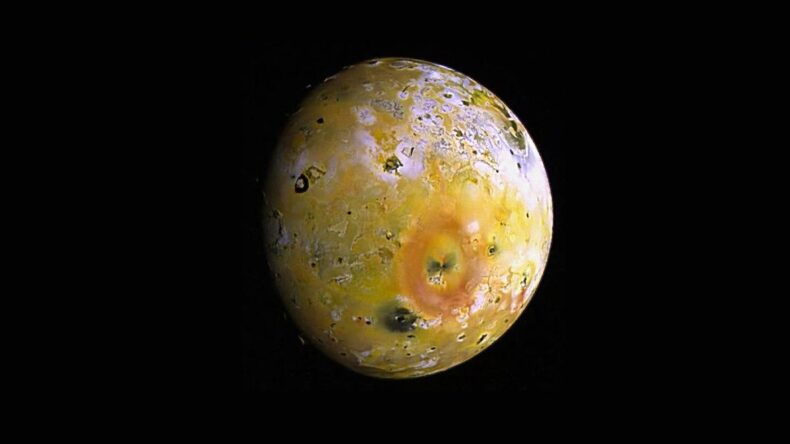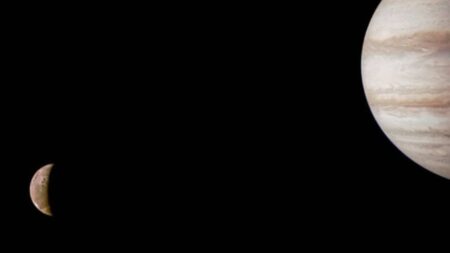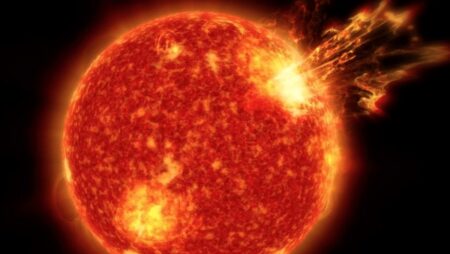According to recent research, Jupiter’s super-volcanic moon has huge, meandering dunes that were not formed by wind but rather by lava flows under the moon’s surface.

Io is Jupiter’s third-largest moon and the innermost of the planet’s four big Galilean satellites. It is the third-largest moon in the solar system after the moons of Saturn and Uranus. Scientists have been baffled by its frosty, but rolling surface for a long period. Scientists have now discovered a novel explanation for how such dunes may originate, based on data collected by NASA’s Galileo probe. The 14-year mission, which studied the Jupiter system from 1995 to 2003, yielded photos that were used to construct the first precise maps of Jupiter’s moons, which were then utilized by the study team to get a better understanding of the physical mechanisms that drive grain motion on the moon Io.
“Our research suggests that the moon Io might be a new ‘dune world,’” said George McDonald, the study’s lead author, and an astronomer at Rutgers University in New Jersey, in a statement. A method for sand grains to migrate has been hypothesized and quantitatively evaluated, and dunes may be building in this area as a result of this movement.”
Io, Jupiter’s volcanic moon, was photographed with dunes. The black material in the lower left is freshly emplaced lava flows, while the brilliant, white regions might represent newly emplaced grains as the lava flows evaporate nearby ice.
Dunes are described by nature as hills or ridges of sand that have been heaped up by the wind. However, due to the low density of the moon’s atmosphere, Io’s winds are feeble, leading scientists to believe that the moon’s dunes were generated by some other process.
This research indicates that the conditions in which dunes may be found are far more diversified than the conventional, unending desert landscapes observed on sections of the Earth or Arrakis, a fictitious planet featured in the science fiction film ‘Dune’, McDonald said.
Io is the most volcanically active globe in the solar system, with hundreds of volcanoes, some of which shoot sulfurous plumes hundreds of miles or kilometers into the sky. Io is home to the most active volcanoes in the solar system. This level of volcanic activity results in a diverse surface that includes a mixture of black hardened lava flows and sand, flowing “effusive” lava streams, and Sulphur dioxide “snows.”
To replicate the force necessary to move grains on Io, McDonald and his colleagues employed mathematical equations, and they computed the direction that the grains would travel. According to the statement, the study simulated the movement of a single grain of basalt or frost, and the results revealed that the interaction between flowing lava and Sulphur dioxide beneath the moon’s surface results in venting that is dense and fast-moving enough to form large dune-like features on the moon’s surface.
Observations from NASA’s Galileo spacecraft corroborate the researchers’ results, demonstrating that the spacing and height-to-width ratios of Io’s crests are compatible with dunes seen on Earth and other planets, according to the researchers.
Lujendra Ojha, the co-author of the research and a planetary scientist at Rutgers University, said in a statement that “work like this truly enables us to comprehend how the universe works.” Finally, in planetary science, it is precisely what we are attempting to achieve. sbtreatment.com “
Lujendra Ojha, the co-author of the research and a planetary scientist at Rutgers University, said in a statement that “work like this truly enables us to comprehend how the universe works.” Finally, in planetary science, it is precisely what we are attempting to achieve. “
Published by- NIKITA GOSWAMI













